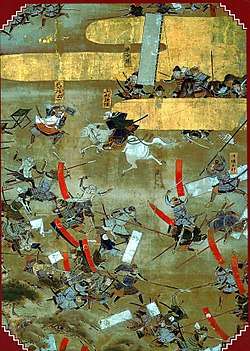Ko-ryū
| Ko-ryū | |||||
 Centuries of feudal warfare in Japan, and the desire to perfect the skills for war, led to the creation of the traditional schools of Japanese martial arts. | |||||
| Japanese name | |||||
|---|---|---|---|---|---|
| Kanji |
古流 (Koryū) or 古武道 (Kobudō) | ||||
| Hiragana | こりゅう | ||||
| |||||
Ko-ryū (古流, "old style") is a Japanese term for Japanese martial arts that predate the Meiji Restoration (1868). The term is synonymous with Kobudo (古武道, ancient martial arts) and contrasted with Gendai budō "modern martial arts" (or shinbudō "new martial arts") which refer to schools developed after the Meiji Restoration.[1][2]
Distinction
In Japanese, Ko-ryū (古流) Kobudō (古武道) are normally treated as synonyms (for example, All Japan Kendo Federation,[3]). But in English, the International Hoplology Society makes a distinction between Ko-ryū and Kobudō concerned the origin and the difference between the ranking of priorities concerning combat, morals, discipline and/or aesthetic form.[4]
Description of Koryū
The term Ko-ryū (古流) literally translates as "old school" (ko—old, ryū—school) or "traditional school". Koryū is also a general term for Japanese schools of martial arts that predate the Meiji Restoration (1868) which sparked major socio-political changes and led to the modernization of Japan.[5]
The system of Koryū is considered in following priorities order: 1) combat, 2) discipline 3) morals.[6][7]
Description of Kobudō
Kobudō (古武道) is a Japanese term for a system that can be translated as 古 (old) 武 (martial) 道 (way) "old martial art"; the term appeared in the first half of the seventeenth century.[8] Kobudō marks the beginning of the Tokugawa period (1603–1868) also called the Edo period, when the total power was consolidated by the ruling Tokugawa clan.[9]
The system of kobudō is considered in following priorities order: 1) morals, 2) discipline 3) aesthetic form.[6][7]
Okinawan kobudō
Kobudō can also be used to refer to Okinawan kobudō where it describes collectively all Okinawan combative systems. These are entirely different and basically unrelated systems. The use of the term kobudō should not be limited, as it popularly is, to the describing of the ancient weapons systems of Okinawa.[10][11]
Examples of skills taught in koryū or kobudō
See also
Sources
- Draeger, Donn F. Classical Bujitsu (Martial Arts and Ways of Japan). Weatherhill, 1973, 2007. ISBN 978-0834802339
- Hall, David A. Encyclopedia of Japanese Martial Arts. Kodansha USA, 2012. ISBN 978-1568364100
- Skoss, Diane, Editor. Koryu Bujutsu: Classical Warrior Traditions of Japan. Koryubooks, 1997. ISBN 978-1890536046
- Skoss, Diane, Editor. Sword and Spirit: Classical Warrior Traditions of Japan, Volume 2. Koryubooks, 1999. ISBN 978-1890536053
- Skoss, Diane, Editor. Keiko Shokon: Classical Warrior Traditions of Japan, Volume 3. Koryubooks, 2002. ISBN 978-1890536060
References
- ↑ Draeger, Donn F. (1974) Modern Bujutsu and Budo. New York: Weatherhill. Page 57. ISBN 0-8348-0351-8
- ↑ Fumon Tanaka (2003) Samurai Fighting Arts: The Spirit and the Practice. Tokyo: Kodansha International Ltd. Page 22. ISBN 4-7700-2898-9
- ↑ Japanese-English Dictionary of Kendo. All Japan Kendo Federation. Tokyo. Japan. 2000. Page 52.
- ↑ Armstrong, Hunter B. (1995) The Koryu Bujutsu Experience in Koryu Bujutsu - Classical Warrior Traditions of Japan. Page 19-20. ISBN 1-890536-04-0
- ↑ Armstrong, Hunter B. (1995) The Koryu Bujutsu Experience in Koryu Bujutsu - Classical Warrior Traditions of Japan. New Jersey: Koryu Books. Page 20. ISBN 1-890536-04-0
- 1 2 Donn F. Draeger, 1973. Classical Budo. ISBN 978-0-8348-0234-6. Page 36
- 1 2 Armstrong, Hunter B. (1995) The Koryu Bujutsu Experience in Koryu Bujutsu - Classical Warrior Traditions of Japan. New Jersey: Koryu Books. Page 20. ISBN 1-890536-04-0
- ↑ Draeger, Donn F. (1973) Classical Budo. Boston: Weatherhill. Page 68. ISBN 978-0-8348-0234-6
- ↑ Knutsen, Roald (2004) Rediscovering Budo. Kent: Global Oriental. Page 22-23. ISBN 1-901903-61-3
- ↑ Donn F. Draeger, 1974. Modern Bujutsu & Budo. ISBN 0-8348-0351-8. Page 135.
- ↑ Armstrong, Hunter B. (1995) The Koryu Bujutsu Experience in Koryu Bujutsu - Classical Warrior Traditions of Japan. New Jersey: Koryu Books. Pages 19-20. ISBN 1-890536-04-0
External links
- What is Koryu?
- Koryu.com in English. Provides articles and links to books.
- KoryuWeb in French and English.